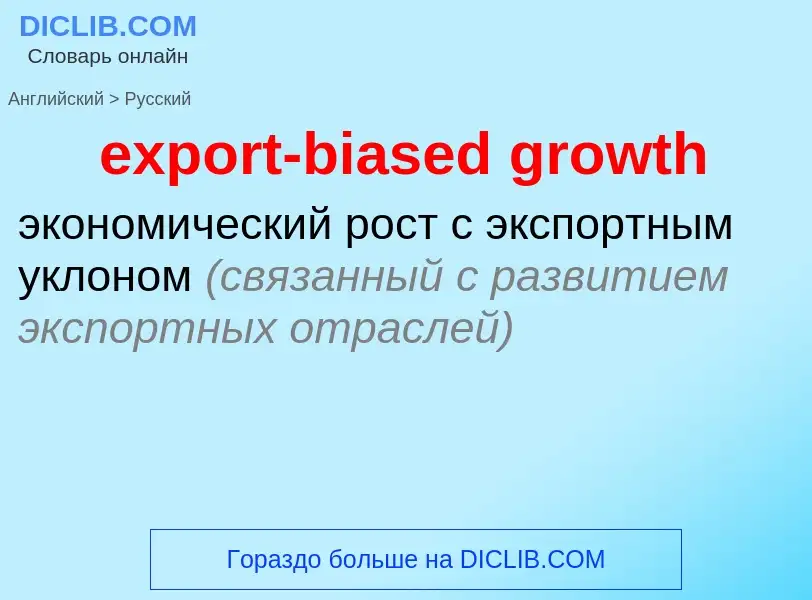Перевод и анализ слов искусственным интеллектом ChatGPT
На этой странице Вы можете получить подробный анализ слова или словосочетания, произведенный с помощью лучшей на сегодняшний день технологии искусственного интеллекта:
- как употребляется слово
- частота употребления
- используется оно чаще в устной или письменной речи
- варианты перевода слова
- примеры употребления (несколько фраз с переводом)
- этимология
export-biased growth - перевод на русский
[grəuθ]
общая лексика
рост
развитие
произрастание
выращивание
культивирование
растительность
поросль
новообразование
возрастание
вырост
выростковый
нарастание
нарост
обрастание
порядок роста
прирост
разрастание
разращение
ростовой
увеличение
медицина
рост (процесс)
строительное дело
наращивание
растительный покров
существительное
общая лексика
рост
развитие
прирост
увеличение
усиление
распространение
выращивание
культивирование
произрастание
культура (бактерий)
плод
продукт
предмет выращивания
растительность
поросль
щетина
урожай
рост, развитие
прирост, увеличение
выращивание, культивирование
медицина
опухоль
новообразование
новообразование, опухоль
бактериология
культура
синоним
2) выращивание
3) происхождение
- growth by merger
- growth in the living standard
- of domestic growth
- of foreign growth
- of other growth
- growth of technology
- abnormal growth
- balanced growth
- closed population growth
- damped growth
- economic growth
- efficient growth
- equilibrium growth
- exponential growth
- export-biased growth
- import-biased growth
- intercensal growth
- internal growth of company
- job growth
- logistic population growth
- monetary growth
- money growth
- natural population growth
- open population growth
- population growth
- secular growth
- stable growth
- stunted growth
- sustainable growth
- sustained growth
- unbalanced growth
- zero growth
[grəun]
общая лексика
расти
выросший
прилагательное
[grəun]
общая лексика
взрослый
past participle от grow
Определение
Википедия

Export-oriented industrialization (EOI) sometimes called export substitution industrialization (ESI), export led industrialization (ELI) or export-led growth is a trade and economic policy aiming to speed up the industrialization process of a country by exporting goods for which the nation has a comparative advantage. Export-led growth implies opening domestic markets to foreign competition in exchange for market access in other countries.
However, this may not be true of all domestic markets, as governments may aim to protect specific nascent industries so they grow and are able to exploit their future comparative advantage and in practice the converse can occur. For example, many East Asian countries had strong barriers on imports from the 1960s to the 1980s.
Reduced tariff barriers, a fixed exchange rate (a devaluation of national currency is often employed to facilitate exports), and government support for exporting sectors are all an example of policies adopted to promote EOI and, ultimately, economic development. Export-oriented industrialization was particularly characteristic of the development of the national economies of the developed East Asian Tigers: Hong Kong, Singapore, South Korea, and Taiwan in the post-World War II period.
Export-led growth is an economic strategy used by some developing countries. This strategy seeks to find a niche in the world economy for a certain type of export. Industries producing this export may receive governmental subsidies and better access to the local markets. By implementing this strategy, countries hope to gain enough hard currency to import commodities manufactured more cheaply elsewhere.
In addition, a recent mathematical study shows that export-led growth is where wage growth is repressed and linked to the productivity growth of non-tradable goods in a country with under-valued currency. In such a country, the productivity growth of export goods is greater than the proportional wage growth and the productivity growth of non-tradable goods. Thus, export price decreases in the export-led growth country and makes it more competitive in international trade.




![Productivity lowered the cost of most items in terms of work time required to purchase. Real [[food prices]] fell due to improvements in transportation and trade, [[mechanized agriculture]], [[fertilizer]]s, scientific farming and the [[Green Revolution]]. Productivity lowered the cost of most items in terms of work time required to purchase. Real [[food prices]] fell due to improvements in transportation and trade, [[mechanized agriculture]], [[fertilizer]]s, scientific farming and the [[Green Revolution]].](https://commons.wikimedia.org/wiki/Special:FilePath/Cost of chicken in time worked.jpg?width=200)

